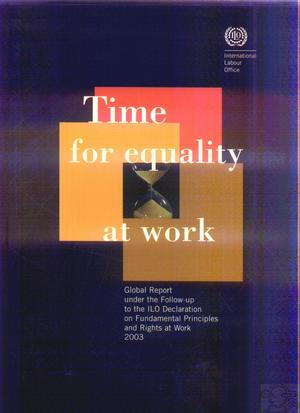Time for equality at work
İÇİNDEKİLERContents Executive summary Introduction Part I. From principle to reality 1. Growing international recognition of the need to eliminate discrimination in the world of work . . The ILO: A key player in building international consensus. Social mobilization and organization: The drive behind international recognition and commitment 2. Discrimination: What should be eliminated and why? What is discrimination? Discrimination in employment and occupation: What work situations are covered? Types of discrimination What does not constitute discrimination Why does discrimination persist? The role of labour market institutions and processes Denying or downplaying discrimination Why it is important to eliminate discrimination at work The link between discrimination and poverty . . . 3. The changing face of discrimination at work Racial discrimination: Continuity and change . . . Religious discrimination: The need for better scrutiny and understanding The challenge of eliminating discrimination against people living with HIV/AIDS. .........Discrimination on the grounds of disability Age as a determinant of discrimination in the labour market Multiple discrimination: The accumulation of deprivation Part II. Selected trends and policy issues 1. Gender inequalities in the labour market as a proxy for sex-based discrimination at work Discrimination at entry to the labour market Discrimination in occupation. Determinants of occupational segregation Trends in occupational segregation Discrimination in remuneration. Where does the problem lie and why is it important to tackle it? ............................. Determinants of discrimination in remuneration Trends in discrimination in remuneration Disparities in earnings based on race The minimum wage 2. Policy issues and interventions Legislation: An indispensable first step Shifts in legal approaches to combat discrimination and promote equality Public procurement policies: A new instrument to promote equality? Enforcement, monitoring and promotion are crucial for sustained change Closing the gap: Affirmative action Has affirmative action brought about the intended results? The importance of gathering the right data Technical and financial considerations Political and ideological orientations. Concerns about privacy Developing a measuring tool Educational and vocational training help inclusion The role of employment services Balancing work and family Why is it important to get the work/family balance right? Fiscal measures Shortening work schedules Care services for children and other dependent family membersMaternity protection and parental leave Family-friendly arrangements promoted by enterprises Part III. The ILO and the social partners in action 1. The ILO: A long history of combating discrimination at work ILO action is rooted in the international labour standards The ILO and racial discrimination: Paving the way for institutional change The ILO in post-apartheid South Africa and Namibia: Building an affirmative action policy Brazil: Campaigning for equality in respect of diversity From a focus on women workers to gender mainstreaming Reducing the rights deficit by promoting women workers' rights More and better jobs for women An enabling environment for women entrepreneurs Empowering women through micro-finance programmes Breaking through the glass ceiling Sexual harassment Tackling gender inequalities in remuneration The trafficking of human beings. Decent work for "invisible" workers: Homeworkers Gender mainstreaming and the gender audit Linking poverty and social exclusion to discrimination at work Mainstreaming gender in anti-poverty policies and programmes. Participation in the Poverty Reduction Strategy Paper process: A window of opportunity to promote equality Public investment programmes: Promoting inclusive approaches and respect of equality standards Challenging discriminatory practices through crisis response Targeted interventions: A focus on disadvantaged and vulnerable groups Promoting indigenous and tribal peoples' rights and livelihoods. Addressing discrimination based on disability and HIV/AIDS status through codes of practice Decent treatment of migrant workers 2. Employers' and workers' organizations: Key partners in achieving equality Voice and representation: Enabling conditions Trade union efforts to reach out to workers without representation Employers' associations: Raising the representation of discriminated-against groups Voice and representation is key to eliminating poverty and social exclusion Collective bargaining: A conduit to equality? Gender equality bargaining: What have we learnt? Equality bargaining beyond gender Enterprises mobilizing for equality The challenge of small and medium-sized enterprises. Beyond national initiatives and national actors Part IV. Towards an action plan to eliminate discrimination at work 1. The way forward Defining the needs for further action by the ILO......................... Three strategies to set the wheels in motion Knowledge. Advocacy. Services 2. Conclusion. Annexes 1. ILO Declaration on Fundamental Principles and Rights at Work and its Follow-up 2. Table of ratifications of ILO Conventions Nos. 100 and 111 ................................. 3. Table 1. Changes in some features of women's participation in the labour market - selected countries Table 2. Unemployment differentials between women and men - selected countries Table 3. Index of dissimilarity (ID) and gender-dominated non-agricultural occupations for selected countries. Table 4. Findings from selected studies using the Oaxaca-Blinder approach: Proportion of the gender pay gap (GPG) attributed to labour market discrimination    |



